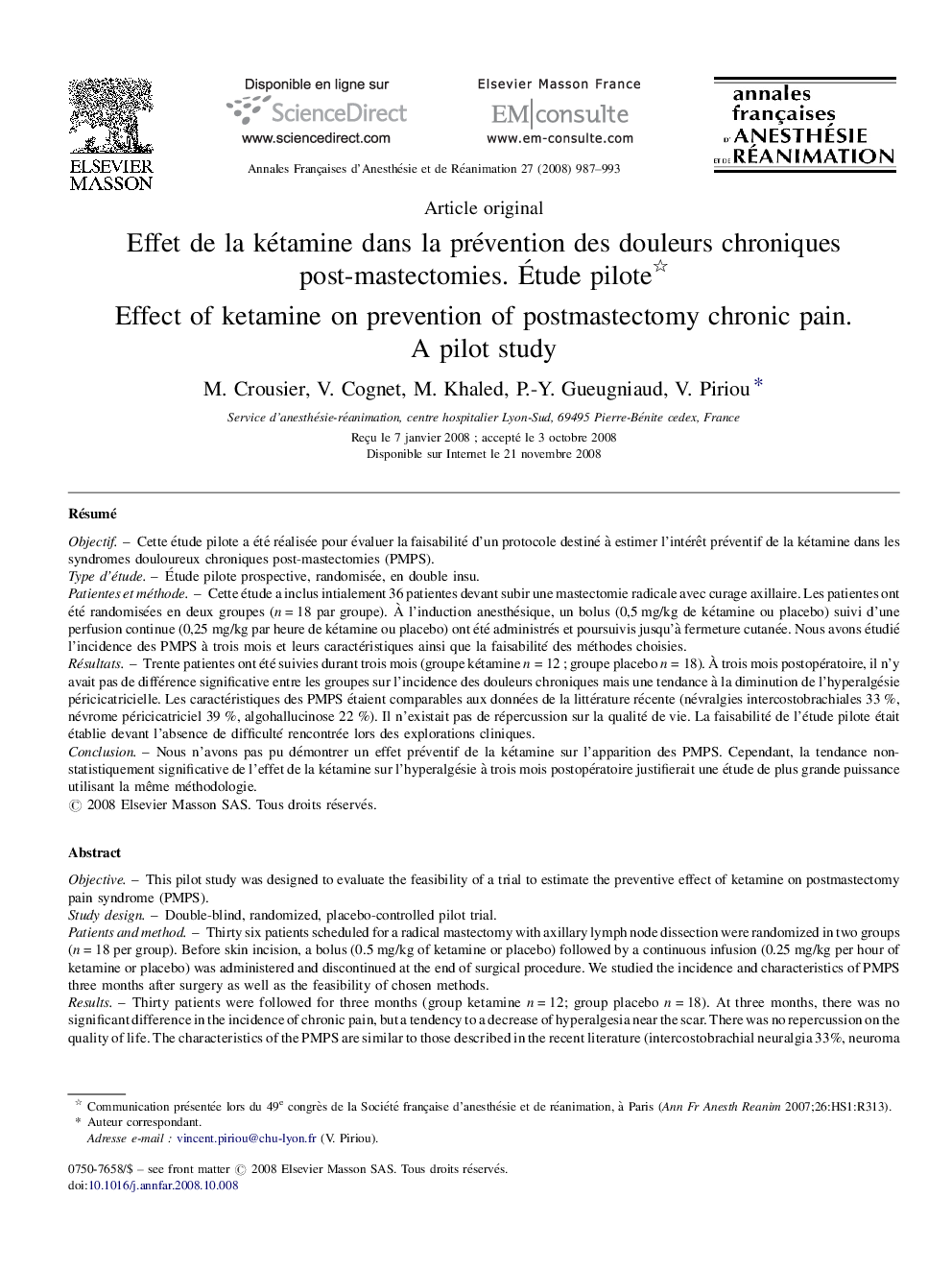| کد مقاله | کد نشریه | سال انتشار | مقاله انگلیسی | نسخه تمام متن |
|---|---|---|---|---|
| 2746683 | 1148883 | 2008 | 7 صفحه PDF | دانلود رایگان |

RésuméObjectifCette étude pilote a été réalisée pour évaluer la faisabilité d’un protocole destiné à estimer l’intérêt préventif de la kétamine dans les syndromes douloureux chroniques post-mastectomies (PMPS).Type d’étudeÉtude pilote prospective, randomisée, en double insu.Patientes et méthodeCette étude a inclus intialement 36 patientes devant subir une mastectomie radicale avec curage axillaire. Les patientes ont été randomisées en deux groupes (n = 18 par groupe). À l’induction anesthésique, un bolus (0,5 mg/kg de kétamine ou placebo) suivi d’une perfusion continue (0,25 mg/kg par heure de kétamine ou placebo) ont été administrés et poursuivis jusqu’à fermeture cutanée. Nous avons étudié l’incidence des PMPS à trois mois et leurs caractéristiques ainsi que la faisabilité des méthodes choisies.RésultatsTrente patientes ont été suivies durant trois mois (groupe kétamine n = 12 ; groupe placebo n = 18). À trois mois postopératoire, il n’y avait pas de différence significative entre les groupes sur l’incidence des douleurs chroniques mais une tendance à la diminution de l’hyperalgésie péricicatricielle. Les caractéristiques des PMPS étaient comparables aux données de la littérature récente (névralgies intercostobrachiales 33 %, névrome péricicatriciel 39 %, algohallucinose 22 %). Il n’existait pas de répercussion sur la qualité de vie. La faisabilité de l’étude pilote était établie devant l’absence de difficulté rencontrée lors des explorations cliniques.ConclusionNous n’avons pas pu démontrer un effet préventif de la kétamine sur l’apparition des PMPS. Cependant, la tendance non-statistiquement significative de l’effet de la kétamine sur l’hyperalgésie à trois mois postopératoire justifierait une étude de plus grande puissance utilisant la même méthodologie.
ObjectiveThis pilot study was designed to evaluate the feasibility of a trial to estimate the preventive effect of ketamine on postmastectomy pain syndrome (PMPS).Study designDouble-blind, randomized, placebo-controlled pilot trial.Patients and methodThirty six patients scheduled for a radical mastectomy with axillary lymph node dissection were randomized in two groups (n = 18 per group). Before skin incision, a bolus (0.5 mg/kg of ketamine or placebo) followed by a continuous infusion (0.25 mg/kg per hour of ketamine or placebo) was administered and discontinued at the end of surgical procedure. We studied the incidence and characteristics of PMPS three months after surgery as well as the feasibility of chosen methods.ResultsThirty patients were followed for three months (group ketamine n = 12; group placebo n = 18). At three months, there was no significant difference in the incidence of chronic pain, but a tendency to a decrease of hyperalgesia near the scar. There was no repercussion on the quality of life. The characteristics of the PMPS are similar to those described in the recent literature (intercostobrachial neuralgia 33%, neuroma pain 39%, and phantom breast pain 22%). The feasibility of the experimental study is established by the absence of difficulty during the clinical investigation period.ConclusionWe found no preventive effect of ketamine on the development of PMPS. However, the non-statistically significant effect of ketamine on hyperalgesia three months after surgery could justify a larger study with the same methodology.
Journal: Annales Françaises d'Anesthésie et de Réanimation - Volume 27, Issue 12, December 2008, Pages 987–993